New Account | Seed Mix |
Gift Certificates |AAS Winners |
Gardening Products
SEEDS: Unusual | Annuals | Perennials | Vegetables | Herbs | Trees
Rain Forest Plant Seeds from around the World
We have carefully selected the following Rain Forest specimens for their ability to be grown indoors. These plants are unique and hold their own special place in nature. We hope that you will share the beauty and wonder of these plants with your friends and family.

D2249 Carob Tree ( Ceratonia )
Ceratonia siliqua, commonly known as the carob tree, St John's-bread, or locust bean is a species of flowering evergreen shrub or tree in the pea family, Fabaceae.
It is widely cultivated for its edible pods, and as an ornamental tree in gardens. The ripe, dried pod is often ground to carob powder, which is used to replace cocoa powder. Carob bars, an alternative to chocolate bars, are often available in health-food stores.
Carob consumed by humans is the dried (and sometimes roasted) pod. The pod consists of two main parts: the pulp accounts for 90% and the seeds for 10% of the pod weight.
Carob is mildly sweet and is used in powdered, chip or syrup form as an ingredient in cakes and cookies, and as a substitute for chocolate. Carob bars are widely available in health food stores. A traditional sweet, eaten during Lent and Good Friday, is also made from carob pods in Malta. Dried carob fruit is traditionally eaten on the Jewish holiday of Tu Bishvat.
While chocolate contains levels of theobromine which are toxic to some mammals, carob contains significantly less caffeine and theobromine, and is therefore used to make chocolate-flavored treats for dogs.
Carob pod meal is used as an energy-rich feed for livestock, particularly for ruminants, though its high tannin content may limit its use. Carob pods were mainly used as animal fodder in the Maltese Islands, apart from times of famine or war when they formed part of the diet of many Maltese. In the Iberian Peninsula, carob pods were used to feed donkeys.
The carob tree is native to the Mediterranean region, including Southern Europe, Northern Africa, the larger Mediterranean islands; to the Levant and Middle-East of Western Asia into Iran; and to the Canary Islands and Macaronesia.
Carob trees may be grown in USDA zones 9-11.
It is widely cultivated for its edible pods, and as an ornamental tree in gardens. The ripe, dried pod is often ground to carob powder, which is used to replace cocoa powder. Carob bars, an alternative to chocolate bars, are often available in health-food stores.
Carob consumed by humans is the dried (and sometimes roasted) pod. The pod consists of two main parts: the pulp accounts for 90% and the seeds for 10% of the pod weight.
Carob is mildly sweet and is used in powdered, chip or syrup form as an ingredient in cakes and cookies, and as a substitute for chocolate. Carob bars are widely available in health food stores. A traditional sweet, eaten during Lent and Good Friday, is also made from carob pods in Malta. Dried carob fruit is traditionally eaten on the Jewish holiday of Tu Bishvat.
While chocolate contains levels of theobromine which are toxic to some mammals, carob contains significantly less caffeine and theobromine, and is therefore used to make chocolate-flavored treats for dogs.
Carob pod meal is used as an energy-rich feed for livestock, particularly for ruminants, though its high tannin content may limit its use. Carob pods were mainly used as animal fodder in the Maltese Islands, apart from times of famine or war when they formed part of the diet of many Maltese. In the Iberian Peninsula, carob pods were used to feed donkeys.
The carob tree is native to the Mediterranean region, including Southern Europe, Northern Africa, the larger Mediterranean islands; to the Levant and Middle-East of Western Asia into Iran; and to the Canary Islands and Macaronesia.
Carob trees may be grown in USDA zones 9-11.
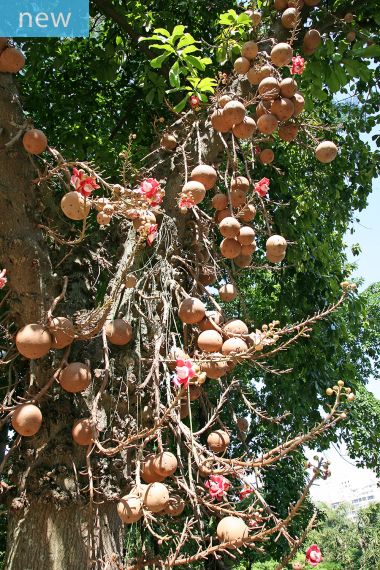
TRZ069 Cannonball Tree ( Couroupita guianensis )
A stunning, large tree with long, spreading branches and blunt-tipped leaves with light green veins, neatly whorled around the branches. The large, red flowers grow on leafless inflorescences directly on the trunk and lower branches. The remarkable fruits are the size, shape and color of a slightly rusty cannonball and a tree loaded with these is quite a sight. Native to tropical lowland forests in Central and South America, Couroupita guianensis is one of three species in this genus and the most well know and widely cultivated in the tropics elsewhere. A great, easy to grow tree for the tropical garden though ideally situated away from walkways and streets because of falling fruits. Zone 10 and higher.
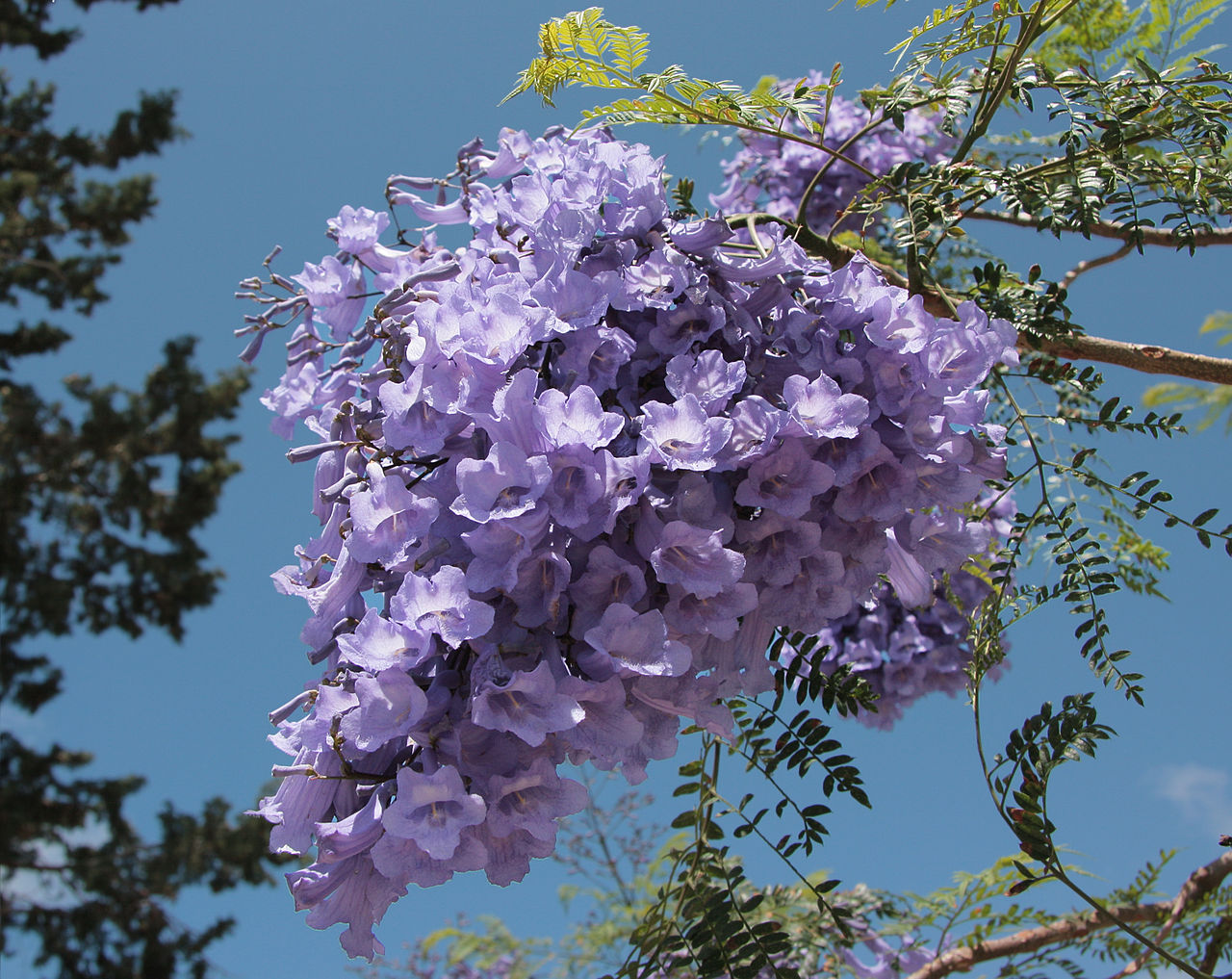
Image: By Anna Anichkova [CC BY-SA 3.0], from Wikimedia Commons
D2905 Jacaranda Tree ( Jacaranda mimosifolia )
Jacaranda mimosifolia is a sub-tropical tree native to south-central South America that has been widely planted elsewhere because of its attractive and long-lasting violet-colored flowers. It is also known as the jacaranda, blue jacaranda, black poui, Nupur or fern tree.
The tree grows to a height of up to 60 or so feet tall in it's native climate, but also makes a good tub plant when young for cooler climates. Its bark is thin and grey-brown, smooth when the tree is young but eventually becoming finely scaly. The twigs are slender and slightly zigzag; they are a light reddish-brown. The flowers are up to 2 inches long, and are grouped in 12 inch panicles. They appear in spring and early summer, and last for up to two months. They are followed by woody seed pods, about 2 inches in diameter, which contain numerous flat, winged seeds. The blue jacaranda is cultivated for the sake of its large compound leaves, as well as it's flowers.
The blue jacaranda has been cultivated in almost every part of the world where there is no risk of frost; established trees, however, tolerate brief spells of temperatures down to around 19 °F. In the US, in areas where winter temperatures can dip to 10 °F for several-hour periods, the mature tree survives with little or no visible damage. Even when young trees are damaged by a hard frost and suffer dieback, they will often rebound from the roots and grow in a shrub-like, multi-stemmed form.
The tree grows to a height of up to 60 or so feet tall in it's native climate, but also makes a good tub plant when young for cooler climates. Its bark is thin and grey-brown, smooth when the tree is young but eventually becoming finely scaly. The twigs are slender and slightly zigzag; they are a light reddish-brown. The flowers are up to 2 inches long, and are grouped in 12 inch panicles. They appear in spring and early summer, and last for up to two months. They are followed by woody seed pods, about 2 inches in diameter, which contain numerous flat, winged seeds. The blue jacaranda is cultivated for the sake of its large compound leaves, as well as it's flowers.
The blue jacaranda has been cultivated in almost every part of the world where there is no risk of frost; established trees, however, tolerate brief spells of temperatures down to around 19 °F. In the US, in areas where winter temperatures can dip to 10 °F for several-hour periods, the mature tree survives with little or no visible damage. Even when young trees are damaged by a hard frost and suffer dieback, they will often rebound from the roots and grow in a shrub-like, multi-stemmed form.
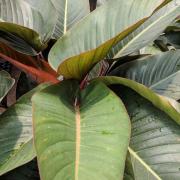
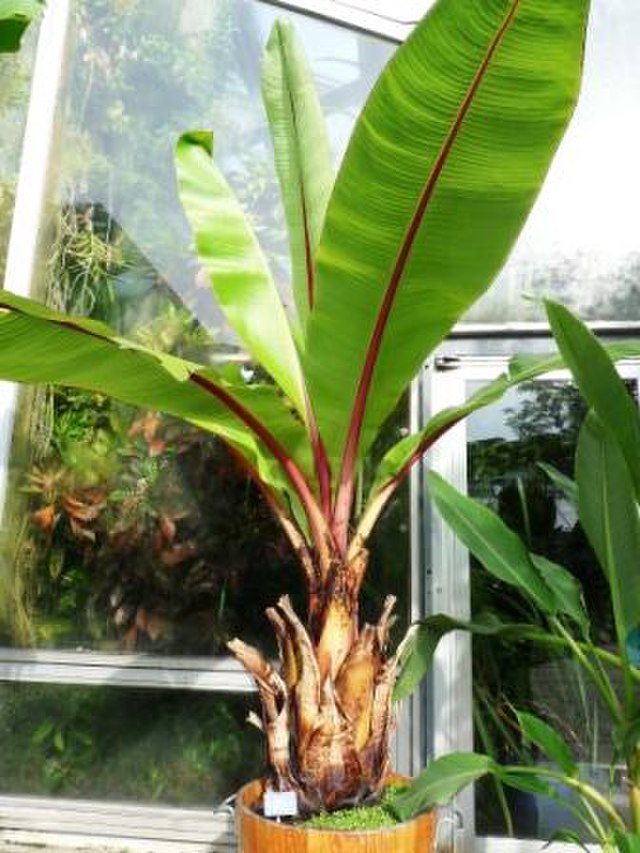
TRZ131 Musa Ensete
This bush type banana is cold hardy into and north of USDA Hardiness Zone 8. Regardless of your climate, you can always enjoy banana type bushes in containers or in greenhouses or as tender perennials. If you crave amazing, tropical, bold-textured foliage and exotic flowers in your garden, you should try growing your own banana bush!
Musa ensete is one of the hardiest types of the Musa family and has very large seeds. This small tree is ideal for conservatories, patios, or as a large potted plant. Only grows about 6 feet tall and is grown for its foliage; unfortunately, no bananas on Musa Ensete. Decorative, huge leaves rivalling any expensive mature house plants. Grows 3 feet in the first four months after seed germination!
Sow anytime of year after soaking the seeds for 24 hours in lukewarm water. Use a peat based seed compost and sow 1/4 inch deep. After sowing, seal the seed container inside a polythene bag in order to keep the compost moist. Germination is slow and erratic and can take 1 - 6 months at 80F. As each seed germinates, transfer it to a 3 in pot of good free draining compost, taking care not to damage the fragile roots. Pot on as required, the larger the container the larger the plant will grow.
Grow Musa ensete bush in warm, well lit conditions. During summer they can be stood outside or planted in the border but should be brought into well lit frost free conditions for the winter when it should be kept moderately dry. Some discoloration of the leaf ends may occur through the winter months but this won't harm the plant.
Zone 8 or higher outside, but often grown as a houseplant or patio plant.
Musa ensete is one of the hardiest types of the Musa family and has very large seeds. This small tree is ideal for conservatories, patios, or as a large potted plant. Only grows about 6 feet tall and is grown for its foliage; unfortunately, no bananas on Musa Ensete. Decorative, huge leaves rivalling any expensive mature house plants. Grows 3 feet in the first four months after seed germination!
Sow anytime of year after soaking the seeds for 24 hours in lukewarm water. Use a peat based seed compost and sow 1/4 inch deep. After sowing, seal the seed container inside a polythene bag in order to keep the compost moist. Germination is slow and erratic and can take 1 - 6 months at 80F. As each seed germinates, transfer it to a 3 in pot of good free draining compost, taking care not to damage the fragile roots. Pot on as required, the larger the container the larger the plant will grow.
Grow Musa ensete bush in warm, well lit conditions. During summer they can be stood outside or planted in the border but should be brought into well lit frost free conditions for the winter when it should be kept moderately dry. Some discoloration of the leaf ends may occur through the winter months but this won't harm the plant.
Zone 8 or higher outside, but often grown as a houseplant or patio plant.
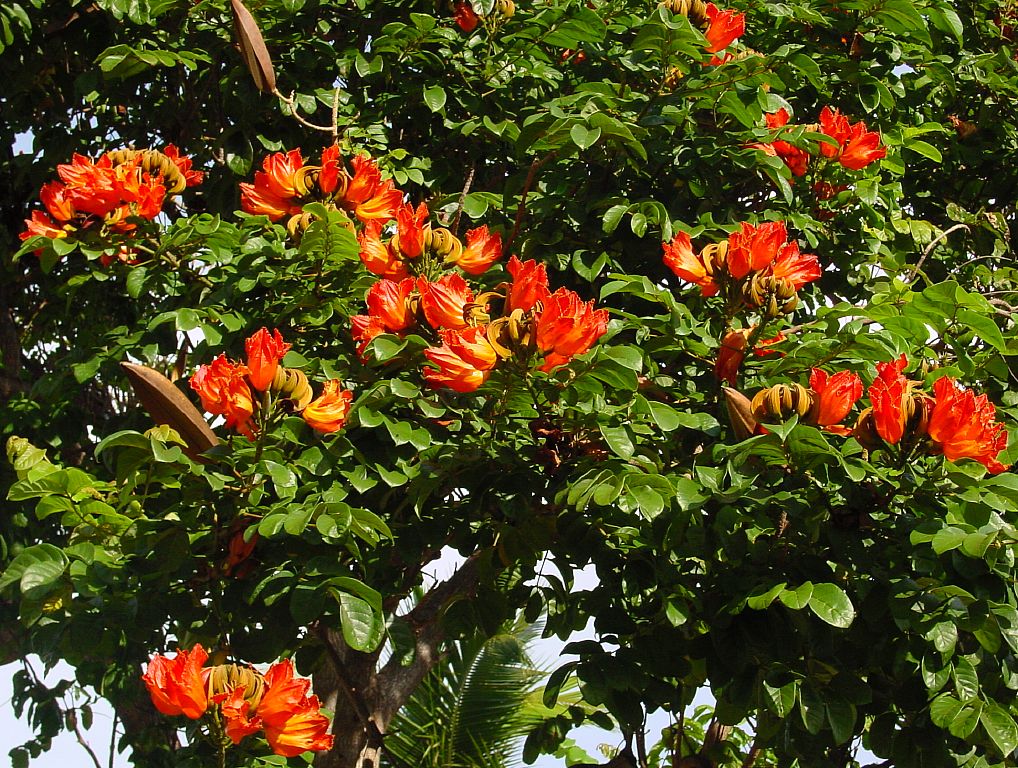
Image: By Wouter Hagens [Public domain], from Wikimedia Commons
LET910 African Tulip Tree ( Spathodea campanulata )
This is a large upright tree with glossy deep green pinnate leaves and glorious orange scarlet flowers. It may grow to 80 ft on an ideal site, but most specimens are much smaller. The tree has a stout, tapering, somewhat buttressed trunk covered in warty light gray bark. The lateral branches are short and thick. The 1-2 feet long opposite leaves, which emerge a bronzy color, are massed at the ends of the branches. They are composed of 5-19 deeply veined oval leaflets.
The horn shaped velvety olive buds appear in upturned whorls at the branch tips. A few at a time, the buds of the lowest tier bend outward and open into big crinkled red orange tuliplike bells with red streaked gold throats, frilly yellow edges, and four brown-anthered stamens in the center. They are followed by 5-10 inch green brown fingerlike pods pointing upwards and outwards above the foliage. Each of these pods contains about 500 tissue papery seeds. The tree flowers in spurts all through the growing season, but peak bloom is usually in the spring.
This species loves rich soil, but puts up with just about anything with a little fertility to it, including limerock. It is not a beachfront plant, but will survive a bit of salinity. African tuliptrees need serious pruning after every freeze or windstorm. Gardeners in marginal regions should plan on growing this as a large ephemeral shrub and plant it in a sheltered place where it can be reached by ladders or bucket trucks for regular pruning and removal of dead branches. Light: African tuliptree will survive in shade, but demands full sun for fast growth and best flowering.
Moisture: These trees grow best with plenty of moisture, but will shed their leaves and endure drought.
Hardiness: USDA Zones 10-11. African tuliptrees drop their leaves when chilled and freeze easily, but they come back from the roots vigorously and often bloom the next season. Top growth will be killed at 28-30 degrees but the roots may survive down to 22 degrees or below.
The smooth gray bark provides a beautiful background for the brilliant red flowers of the African tuliptree. Usage African tuliptrees are grown for shade, color and tropical effects. The wood is difficult to burn, so the tree is also valuable for fire resistant landscaping. The wood has been used for blacksmith's bellows and the like. The buds contain a liquid that will squirt out if they are squeezed or pierced and children enjoy using these as water pistols. They also enjoy playing with the boatlike open seed pods. In Africa and Haiti, the flowers are thought to have magical properties and the wood is used for witch doctors' wands.
Features This is one of the world's most spectacular flowering trees. It is also very fast growing. Young trees may put on 6 feet in height and 2 inches in diameter per year and often begin blooming when they are only a few years old.
The horn shaped velvety olive buds appear in upturned whorls at the branch tips. A few at a time, the buds of the lowest tier bend outward and open into big crinkled red orange tuliplike bells with red streaked gold throats, frilly yellow edges, and four brown-anthered stamens in the center. They are followed by 5-10 inch green brown fingerlike pods pointing upwards and outwards above the foliage. Each of these pods contains about 500 tissue papery seeds. The tree flowers in spurts all through the growing season, but peak bloom is usually in the spring.
This species loves rich soil, but puts up with just about anything with a little fertility to it, including limerock. It is not a beachfront plant, but will survive a bit of salinity. African tuliptrees need serious pruning after every freeze or windstorm. Gardeners in marginal regions should plan on growing this as a large ephemeral shrub and plant it in a sheltered place where it can be reached by ladders or bucket trucks for regular pruning and removal of dead branches. Light: African tuliptree will survive in shade, but demands full sun for fast growth and best flowering.
Moisture: These trees grow best with plenty of moisture, but will shed their leaves and endure drought.
Hardiness: USDA Zones 10-11. African tuliptrees drop their leaves when chilled and freeze easily, but they come back from the roots vigorously and often bloom the next season. Top growth will be killed at 28-30 degrees but the roots may survive down to 22 degrees or below.
The smooth gray bark provides a beautiful background for the brilliant red flowers of the African tuliptree. Usage African tuliptrees are grown for shade, color and tropical effects. The wood is difficult to burn, so the tree is also valuable for fire resistant landscaping. The wood has been used for blacksmith's bellows and the like. The buds contain a liquid that will squirt out if they are squeezed or pierced and children enjoy using these as water pistols. They also enjoy playing with the boatlike open seed pods. In Africa and Haiti, the flowers are thought to have magical properties and the wood is used for witch doctors' wands.
Features This is one of the world's most spectacular flowering trees. It is also very fast growing. Young trees may put on 6 feet in height and 2 inches in diameter per year and often begin blooming when they are only a few years old.
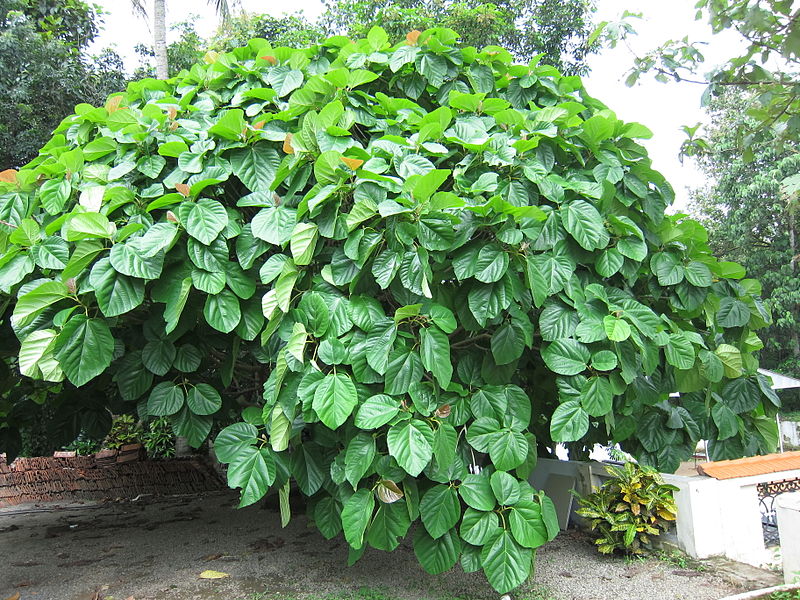
Image: കാക്കര [CC BY-SA 3.0], from Wikimedia Commons
D9916 Elephant Ear Fig ( Ficus auriculata )
A beautiful fig tree with very large oval leaves to 15". The leaves are bright red when they are developing and
exceptionally attractive - the decorative 2 1/2" fruits develop in clusters ( not edible ). This fast growing tree grows to 25' and develop a spreading canopy of 25' but can be kept pruned to a much smaller height.
Makes a sensational indoor specimen. seeds. Cold hardy to 25-30 degrees.
Makes a sensational indoor specimen. seeds. Cold hardy to 25-30 degrees.

W254 Drunken Parrot Tree ( Schotia brachypetala )
The name Drunken Parrot Tree comes from the fact that individual flowers contain so much nectar that it has a tendency to ferment before the birds can eat it all, resulting in a mild narcotic effect on the birds.
These tropical trees will start blooming when they are still quite young. The abundance of rich deep red flowers are produced straight after the new leaves during September and October, but exact flowering times will vary from tree to tree. This irregularity in blooming times is of value to the nectar feeding birds, and ensures a longer feeding season. The flowers produce such copious amounts of nectar that it literally 'weeps' from the flowers.
This is an exceptional ornamental tree for gardens and parks and looks wonderful as part of a larger landscape, or planted singly as a specimen tree. Do not plant it near paved areas or car parks etc, where the dripping nectar could become a problem. When in bloom it will attract a wide variety of birds, animals and insects. The nectar will attract nectar-feeding birds like sunbirds, the nectar will also attract many insects, and therefore insect-eating birds.
Easy to grow in warm frost-free areas, where it remains evergreen and grows surprisingly fast. In colder, dry, inland regions it is slower-growing and deciduous, losing its leaves for a short period in winter or spring. It is semi-hardy to moderate frost if it is planted in a protected part of the garden and young trees are covered in winter, until they are more established. An established tree can withstand minimum winter temperatures of about 24 degrees. It is remarkably hardy in dry regions with poor soil, but for best results in the garden, plant in deep very well-drained soil, to which generous quantities of compost has been added and a dressing of bonemeal. A general purpose granular fertiliser can be used during the growing season. It loves in full sun and will respond well to judicious watering in the garden, especially when young, and during prolonged dry periods.
These tropical trees will start blooming when they are still quite young. The abundance of rich deep red flowers are produced straight after the new leaves during September and October, but exact flowering times will vary from tree to tree. This irregularity in blooming times is of value to the nectar feeding birds, and ensures a longer feeding season. The flowers produce such copious amounts of nectar that it literally 'weeps' from the flowers.
This is an exceptional ornamental tree for gardens and parks and looks wonderful as part of a larger landscape, or planted singly as a specimen tree. Do not plant it near paved areas or car parks etc, where the dripping nectar could become a problem. When in bloom it will attract a wide variety of birds, animals and insects. The nectar will attract nectar-feeding birds like sunbirds, the nectar will also attract many insects, and therefore insect-eating birds.
Easy to grow in warm frost-free areas, where it remains evergreen and grows surprisingly fast. In colder, dry, inland regions it is slower-growing and deciduous, losing its leaves for a short period in winter or spring. It is semi-hardy to moderate frost if it is planted in a protected part of the garden and young trees are covered in winter, until they are more established. An established tree can withstand minimum winter temperatures of about 24 degrees. It is remarkably hardy in dry regions with poor soil, but for best results in the garden, plant in deep very well-drained soil, to which generous quantities of compost has been added and a dressing of bonemeal. A general purpose granular fertiliser can be used during the growing season. It loves in full sun and will respond well to judicious watering in the garden, especially when young, and during prolonged dry periods.
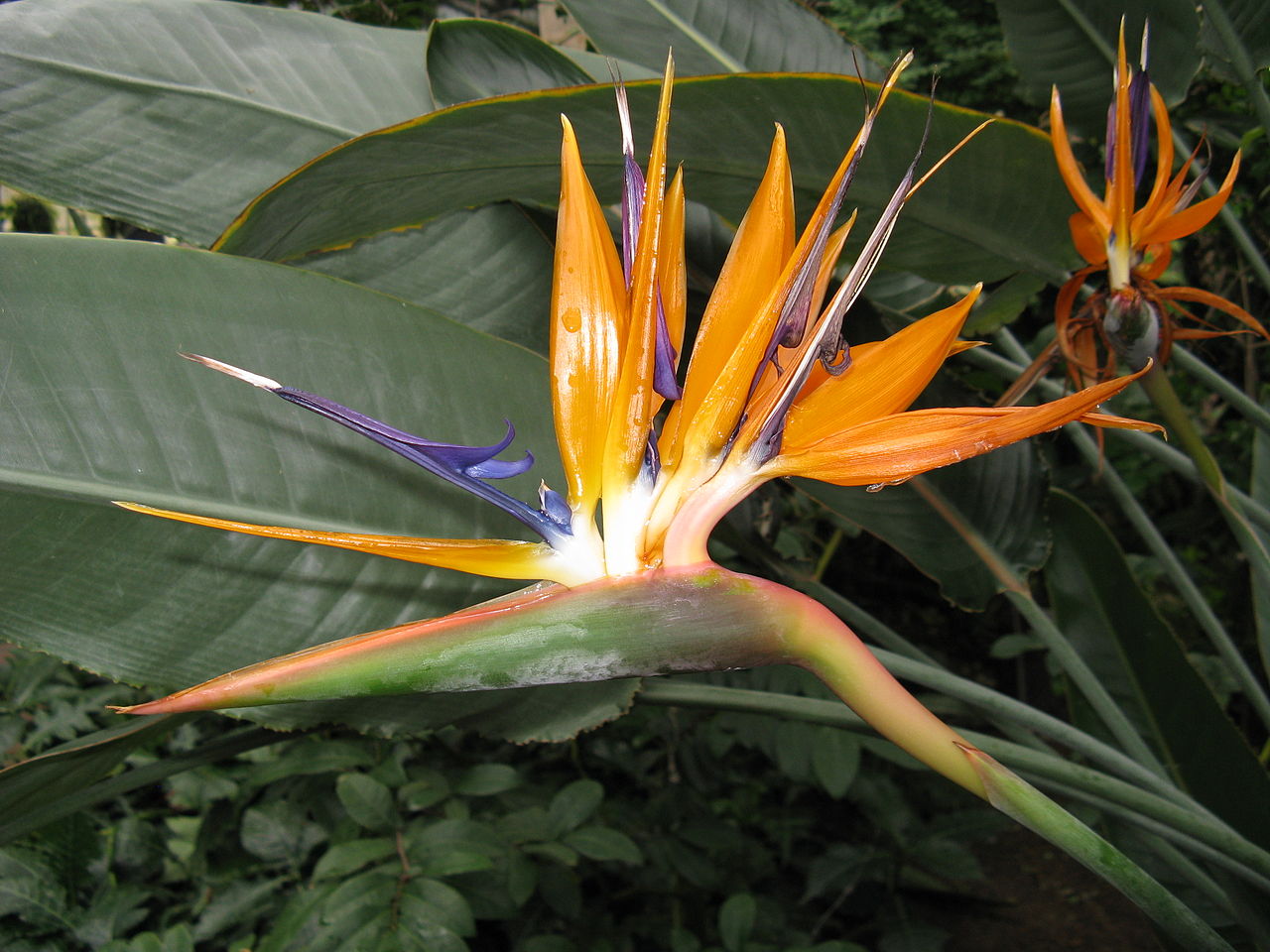
D1109 Bird of Paradise ( Strelitzia reginae )
One of the most attractive of all tropical plants.
The Bird of Paradise is delightfully easy to care for and enjoys warm, balmy days year round. The stunning flowers of this unique plant make it popular in gardens around the globe.
Flowering occurs multiple times a year if the plant is well taken care of. It is a long lived plant, and takes up to three years to begin producing flowers. Once it begins flowering, however, this plant will provide you with years of delight.
Once flowering begins in early spring, each plant will produce up to six flowers in succession, with each flower being long-lived. Blooming can be almost continuous from early spring into early fall, provided the plant is cared for. This plant requires little encouragement to bloom, happy with enough light and water for its needs.
It comes from S Africa. The flowers take shape of a most peculiar form, resembling birds in flight. Grows to a height of about 3 feet in containers, but can reach 6 feet outside.
They can tolerate temperatures as low as 55 degrees, but prefer to remain in the 70-90 degree range.
The Bird of Paradise is delightfully easy to care for and enjoys warm, balmy days year round. The stunning flowers of this unique plant make it popular in gardens around the globe.
Flowering occurs multiple times a year if the plant is well taken care of. It is a long lived plant, and takes up to three years to begin producing flowers. Once it begins flowering, however, this plant will provide you with years of delight.
Once flowering begins in early spring, each plant will produce up to six flowers in succession, with each flower being long-lived. Blooming can be almost continuous from early spring into early fall, provided the plant is cared for. This plant requires little encouragement to bloom, happy with enough light and water for its needs.
It comes from S Africa. The flowers take shape of a most peculiar form, resembling birds in flight. Grows to a height of about 3 feet in containers, but can reach 6 feet outside.
They can tolerate temperatures as low as 55 degrees, but prefer to remain in the 70-90 degree range.
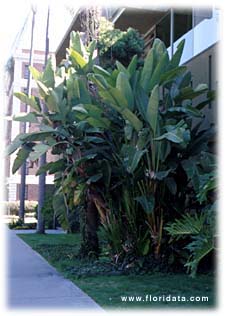
JB268 Giant White Bird of Paradise ( Strelitzia
nicolai )
Bird of paradise is a stunning tropical plant commonly grown as a houseplant throughout the country and a landscape plant in zones 9 and up. These are among the most popular houseplant and patio plants in use today.
This famous giant tropical plant is known for reaching 12 feet or more outdoors in height and bearing loads of brilliant white flowers.
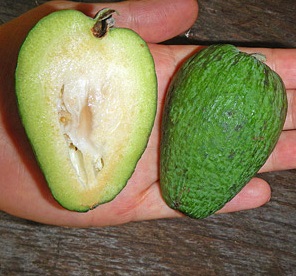
D2925 Pineapple Guava ( Feijoa )
Originally native to southeastern Brazil and northernmost Argentina, this shrub or small tree is now widely cultivated around the world for its edible fruits, as well as for its ornamental qualities. Acca sellowiana grows to about 12-15 feet tall and forms a dense, rounded crown of small leaves that are grayish furry underneath.
The pinkish flowers have prominent red stamens and are followed by plum-sized, yellowish green fruits that are amazingly delicious, highly aromatic, lightly acidic and remind of pineapple and strawberries. They are eaten raw or used in jams, juices or sauces.
Hardy to zone 8.
The pinkish flowers have prominent red stamens and are followed by plum-sized, yellowish green fruits that are amazingly delicious, highly aromatic, lightly acidic and remind of pineapple and strawberries. They are eaten raw or used in jams, juices or sauces.
Hardy to zone 8.
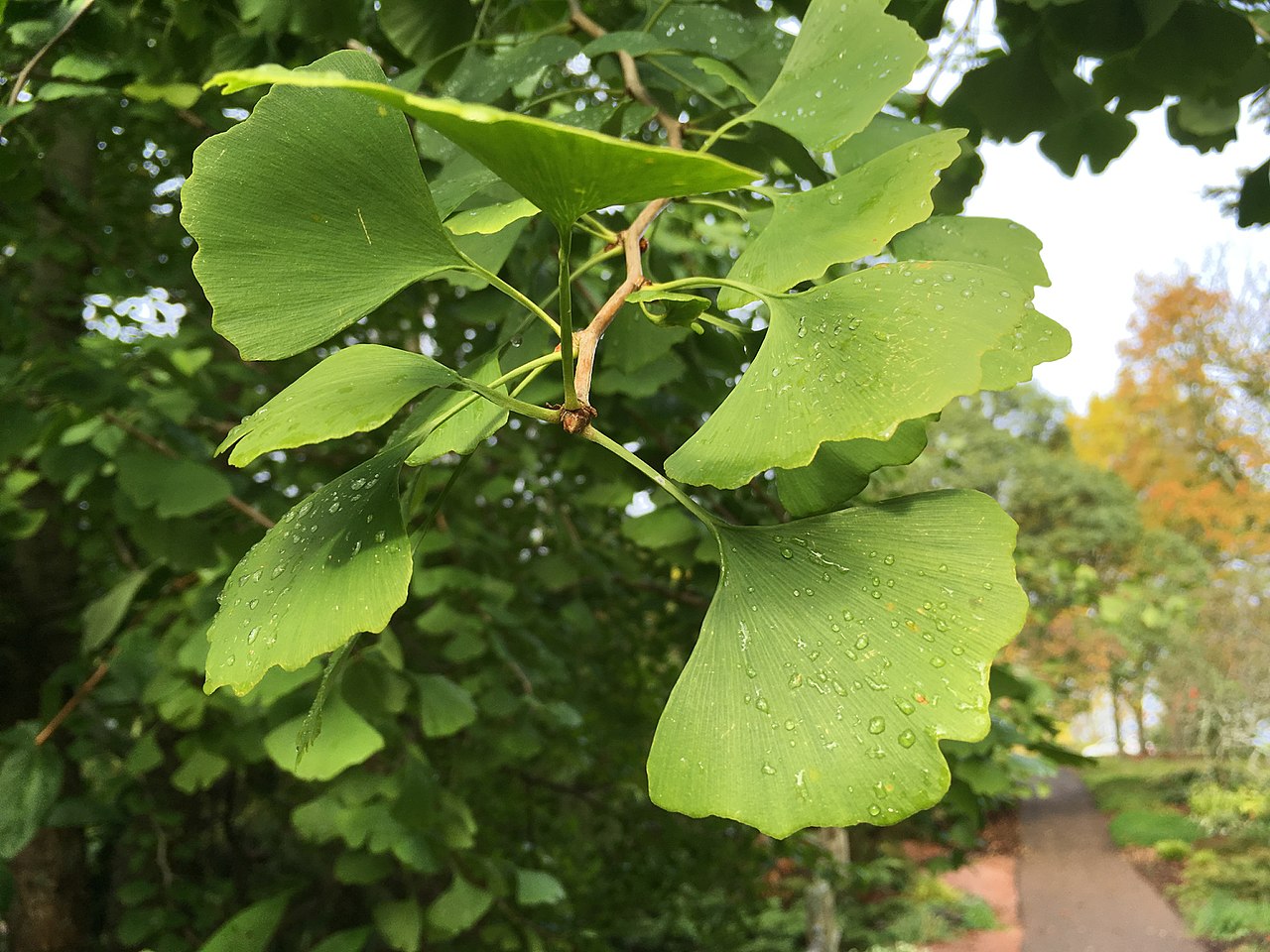
Image: By YSmomilomii [CC BY-SA 4.0], from Wikimedia Commons
D2977 Gingko Biloba
A most unique tree with colorful, beautiful foliage. A great ornamental tree famous for its interesting shape and vibrant foliage, it stands out with a tall, rounded form and delicately-crafted leaves.
Unique, fan-shaped leaves turn a stunning yellow color in the fall. It can tolerate many urban conditions including heat, air pollution, salt, and confined spaces. And it establishes easily. And it thrives just about anywhere in the United States. It's especially perfect for urban areas since it won't be bothered by smog and other pollution.
The Ginkgo tree is a living fossil, with the earliest leaf fossils dating from 270 million years ago. It was rediscovered in 1691 in China and was brought to this country in the late 1700s. The seeds and leaves have been (and are still today) used in medicine throughout the world.
An interesting fact about the ginkgo,there are only five living groups of seed plants, and ginkgo is one of them. And ginkgo is the only one that consists of just one species.
Excellent selection for a variety of uses, including lawn tree, street tree or shade tree. Also effective in city parks or near commercial buildings. A mature tree can grow to 80 feet tall with a 30-40 feet wide canopy. Its nuts are regarded as a delicacy in the Orient. It is the source of the famous herbal supplement. A favorite bonsai specimen. Well suited for zones 3-8.
For more info on the Ginko, please visit the Gingko Page
Unique, fan-shaped leaves turn a stunning yellow color in the fall. It can tolerate many urban conditions including heat, air pollution, salt, and confined spaces. And it establishes easily. And it thrives just about anywhere in the United States. It's especially perfect for urban areas since it won't be bothered by smog and other pollution.
The Ginkgo tree is a living fossil, with the earliest leaf fossils dating from 270 million years ago. It was rediscovered in 1691 in China and was brought to this country in the late 1700s. The seeds and leaves have been (and are still today) used in medicine throughout the world.
An interesting fact about the ginkgo,there are only five living groups of seed plants, and ginkgo is one of them. And ginkgo is the only one that consists of just one species.
Excellent selection for a variety of uses, including lawn tree, street tree or shade tree. Also effective in city parks or near commercial buildings. A mature tree can grow to 80 feet tall with a 30-40 feet wide canopy. Its nuts are regarded as a delicacy in the Orient. It is the source of the famous herbal supplement. A favorite bonsai specimen. Well suited for zones 3-8.
For more info on the Ginko, please visit the Gingko Page

